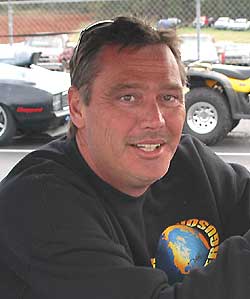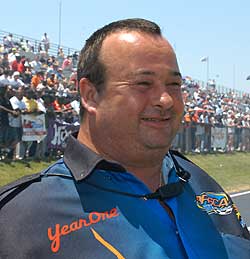News & Analysis
Too Much of a Good Thing?
On the same weekend the National Street Car Association (NSCA) recently passed quietly away, the Atlanta-based Outlaw Racing Street Car Association (ORSCA) announced it has entered negotiations to create a new, larger series and current ORSCA team owner John Ferguson confirmed to DRO he’s interested in establishing a yet-to-be-named rival organization next season.
 Texas King of the Hill head honcho Matt “Big Daddy” Jones supports an initiative to join forces with ORSCA and NSRA to create a bigger, unified outlaw racing presence, but his own car could be at a disadvantage if new rules are not adapted to level the proverbial playing field. |
ORSCA et al may have been part of the problem for 10-year-old NSCA which claimed in its death notice, “demand for the series' services has waned in the face of mounting racer expense and increased local and regional choices.” As if to stress the point, Bill Lutz, an NSCA star in its Super Street ranks, chose that same weekend to enter the Outlaw 10.5 race at ORSCA’s season ender in Huntsville, AL. And Lutz will be back to contest the entire ORSCA schedule in ’08, he says—that is, unless the National Muscle Car Association (NMCA) relents and allows him to run its Super Street class with alcohol coursing through the metal veins of his twin-turboed ’68 Camaro.
Meanwhile, the American Drag Racing League (ADRL) continues to gather steam and entice traditional Outlaw 10.5 racers like Mike Hill, Bobby Cole and two-time NSCA Super Street champ Elliott Thompson to enter its free-for-all Extreme 10.5 class. And here in the Southeast there also are plenty of smaller circuits like Piedmont (NC) Dragway’s “Big Dog” series, the Dixie Pro Stocks and Quick 8 Racing Association for Pro Mod-type doorslammers. In other words, there’s no shortage of venues to race outlaw doorslammers and it appears more are on the way.
Ferguson, who fields the 2000 Camaro in which Steve Kirk Jr. won the 2006 ORSCA Outlaw 10.5 championship, has apparently already tapped highly successful NHRA Top Sportsman racer and promoter Ronnie Davis to organize the Automatic Pro Mod aspect of his planned show and envisions Outlaw 10.5, True 10.5 (with or without wheelie bars) and stock suspension heads-up classes, along with a bracket race, complementing the package. No tracks have been named or dates set so far, but Ferguson insists they would not conflict with ORSCA’s schedule so most teams could run both series, if they choose.
However, no word on how Ferguson’s planned venture might fit in with the merger described in ORSCA’s Nov. 12 press release. It revealed Fenn has entered negotiations with Texas King of the Hill (KOTH) administrator Matt Jones and David Hance, founder and president of the New York-based Northern Street Racing Association (NSRA), to establish for 2008 a seven-event series with two races in Texas, two in the Deep South, and two in Hance’s northern neighborhood, capped off by a championship-deciding blowout offering a six-figure purse for the headlining Outlaw 10.5 class.
“I can’t say that hearing about all that stuff (from Ferguson) didn’t speed up the process, but I talked to Matt Jones about doing something like this at the beginning of the year and Dave Hance and I talked last year about doing a North and South thing, but we never got it done so he ended up doing that race at Piedmont (with Kirk as co-promoter),” Fenn states. “So we talked about all this last year. But the talking is the easy part, anybody can do that; it’s getting it done that’s the hard part.”
The idea behind creating the combined series, he continues, is to finally level the playing field with common rules and standardize performance records for at least the three participating sanctioning bodies and ideally other 10-wide organizers around the country will follow suit. If that happens, a new track record could actually mean something on the opposite side of the country.
The toughest part of the plan probably will be to agree on whose rules to follow, but based on each series’ national presence ORSCA has to be considered the leader. That’s borne out by the few KOTH and NSRA cars that have already tested the waters down south and can successfully run in the various series. The greatest challenge, as usual, will be finding a way to make so many disparate makes and models competitive, especially in the body dimensions realm.
 As an ORSCA team owner, John Ferguson has limited say over the sanctioning body’s direction, so he plans to take matters into his own hands next year with a rival series. |
 After steering ORSCA through four seasons of triumph and turmoil, series president Johnny Fenn now feels its time to expand the organization’s reach beyond its Southeastern stronghold. |
“When you’re racing a ’62 Chevy II that has a front overhang of something like 26 inches compared to a 2000 Camaro that has 40-some inches of overhang it’s going to be very hard to give a Chevy II the same competitive advantage as a Camaro,” Fenn points out. “So here’s what we’ve talked about doing. We know the car that’s out there from the factory with the largest overhang is the Trans Am at 46 inches long. Now, we’ve talked about putting a 42-inch maximum overhang limit on, unless the car came from the factory larger than that. If they have a car like the Trans Am, it will have to be exactly the size of the OEM with no plus-minus tolerance; if it goes past the original length by a quarter inch it’ll be illegal.”
Fenn says he’s had discussions about allowing “flags” bolted to the front end of shorter-overhang cars, much like has become the fashion in Pro Modified racing to even up the beam breaking at the finish line, but it’s not something he really wants to see, especially since Outlaw 10.5 already faces criticism from some quarters that it’s little more than a Baby Pro Mod class. Complicating matters is the fact that KOTH president Jones races an early Nova and would benefit from flagging his car.
More importantly, though, Fenn says he wants to create a sense of cooperation and responsibility among the various promoters. “We have to agree to not book our own races on top of others anywhere in the country because it’ll pull the car count apart and a year or two from now everybody will be asking, ‘What happened to that outlaw thing? It was so hot and it just kind of fizzled out.’ It’s kind of like when local tracks used to run this racing and they all agreed to work together; it didn’t take too long before they were all piled up on top of each other. That doesn’t work.”
He’s right, but with seven weekends taken up with the combined series and ORSCA’s intent to run its own complete points-paying schedule (“We’re not going to be able to take our index classes to Texas or up north; we’ll be running only our pro classes in this deal,” Fenn says. “After a full points racing series within our organization we’ll still crown our ORSCA champions and then with these seven races we’ll crown true world champions.”), that doesn’t leave a lot of opportunity for KOTH and especially NSRA with its more restrictive northern clime to schedule their events.
Then there’s the Ferguson deal to consider and exactly what Fenn fears may become reality—as the NSCA found out—so many events may mean there’s a strong following for this type of racing, but there just won’t be enough cars to go around.
Of course, one way around that would be to somehow bring Ferguson into the fold. Fenn says Ferguson actually made an offer to buy ORSCA, but his partners—outlaw racers Hill and Jack Barfield—wanted no part of that. “There’s no way they wanted to be working for Steve Kirk,” Fenn states.
However, Fenn would welcome Ferguson’s participation—or anyone else’s for that matter—in the joint venture with KOTH and NSRA. “I mean, if there’s 10 people involved and it only makes $1,000 I’m cool with a hundred bucks,” he claims. “The money is not the issue, it’s more important that we all join together to increase the total amount of sponsor dollars that we can get, rather than have someone spend $500 over there and a thousand here and $500 there. Making money is not the issue. All I care about is that we have enough money to pay the racetracks, pay the racers, pay the staff. I have not quit my day job.”
That’s a good thing, because regardless of whether ORSCA is the biggest kid on the Outlaw 10.5 block right now it could all go away in a hurry if the racer pool gets too shallow. And that’s when no one would win, not Fenn, not Ferguson, not Jones, not Hance, and certainly not the racers—and the fans—who follow and support their leads.
To grow, ORSCA does need to move beyond its southern comfort zone and this combined series with KOTH and NSRA might be just the ticket out. It’s an idea whose time has come, but not without risk.
“When everybody started hearing about this thing they came to us with big concerns. Our racers are deeply concerned, all the key guys are concerned because they don’t want it to go back to the way it used to be when they had to pick where they were going to race each weekend and get the other guys mad at them for not showing up at their race,” Fenn says. “They don’t want to go back to that and I don’t blame them.”